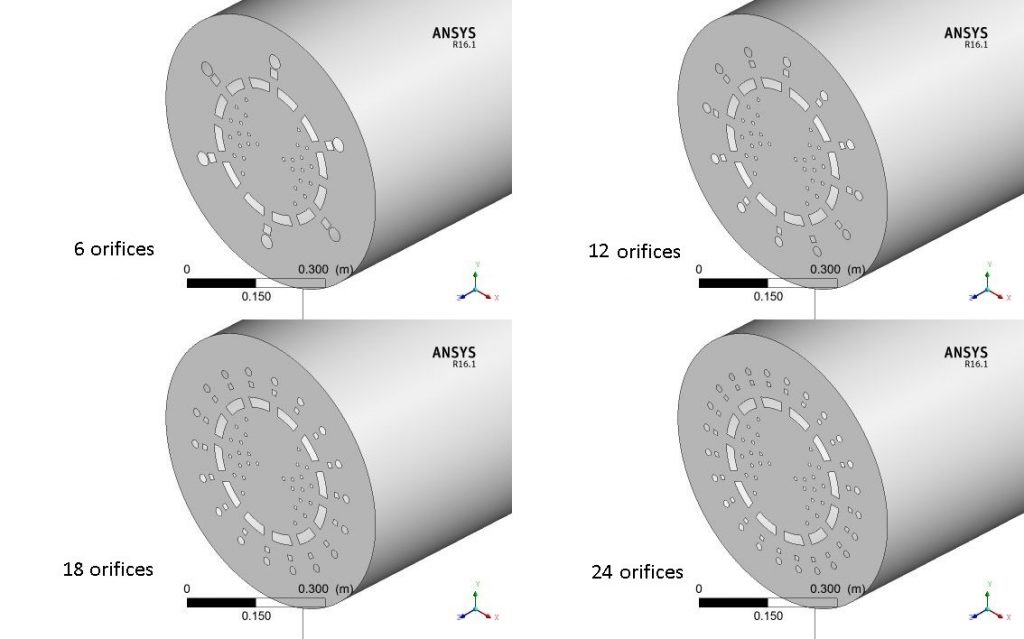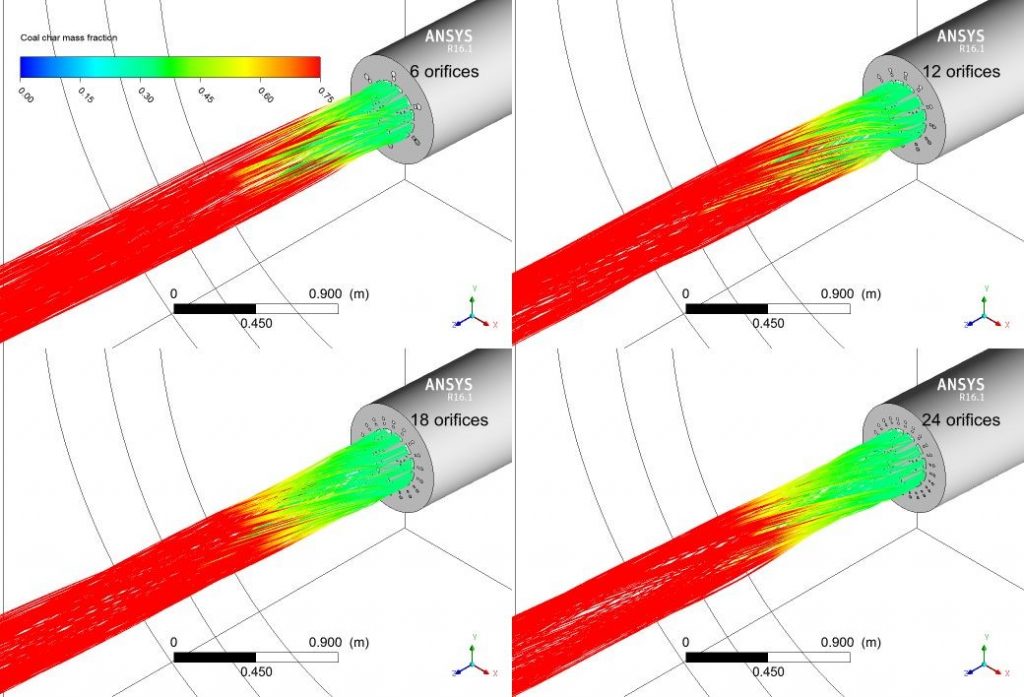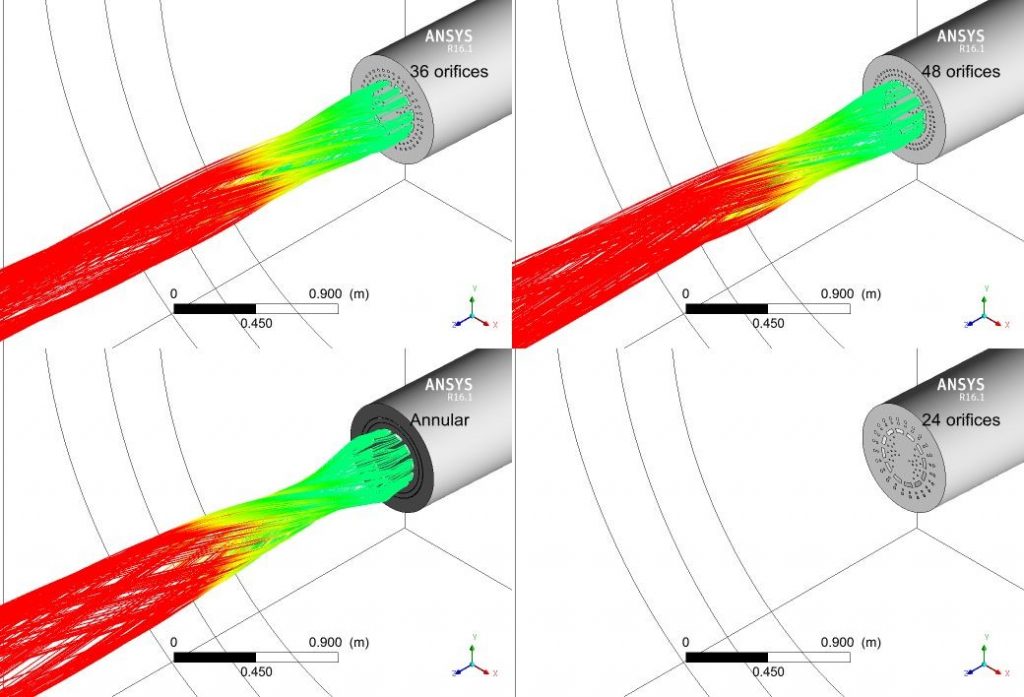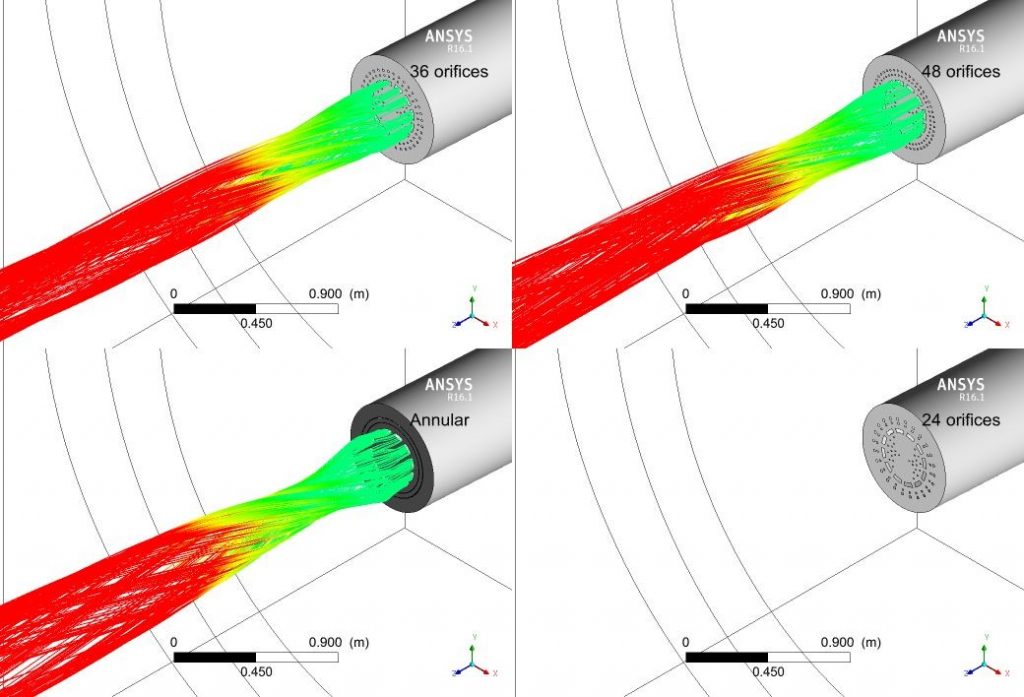Burner designs for modern clinker kilns must fulfil several requirements. Operational flexibility, high durability, low energy consumption, easy tuning, low emissions, and fuel flexibility are some of these requirements to be met. The evaluation of many of these features is straightforward.
Generally, the design of a new burner involves the calculation of:
- flame impulse;
- turbulence index;
- primary air ratio;
- swirl number.
These indices provide essential information regarding efficient fuel combustion and are also used at Dynamis as part of the development of equipment suitable for multiple applications.
Nevertheless, none of them contemplate geometrical aspects which are certainly paramount too if overall performance is to be enhanced. Therefore, relying on these indices alone to evaluate a burner might lead to lack of information on the process once combustion is governed by far more complex phenomena.
Dynamis has recently adopted a more complete methodology to evaluate and compare burner designs in order to develop its new generation of burners: the D-FLAME. This development is the result of many years of Dynamis experience in this field, highly specialised technical body, as well as customer feedback. The new D-Flame burner is the product of a complete analysis of factors crucial to burners’ performance enhancement, such as the one addressed here: the secondary air entrainment into the fuel injection region.
Influence of burner head geometry
For the same primary and secondary air flow rates, and consequently the same swirl, turbulence and impulse indices, tests with different designs for the external and tangential primary air were carried out to verify how the geometry of the burner head might improve not only the burner´s performance but also the whole kiln operation.
Figure 1 presents seven different head designs simulated at Dynamis. Boundary conditions and mathematical models used for fluid flow are the same in all cases studied.
Dynamis believes that the higher the entrainment of secondary air into the fuel injection region, the better the overall performance will be. This is also considered important by others [1].
To measure the calculated secondary air entrainment into the fuel region, several control surfaces, shown in figure 2, were used to evaluate the results obtained with CFD calculations.
On the left hand side of figure 2, it is presented four control surfaces at different cross sections from burner head: CS1, CS2, CS3 and CS4, located, respectively, half a metre, one metre, one and a half metre and two metres away from it.
The cylindrical surface – CS5, pictured on the right hand side of figure 2, is a metre long and half a metre in diameter, and comprises the external primary air channel.
Measurement of secondary air entrainment calculated on these control surfaces (CS1 to CS5) for all geometry design considered are shown on figure 3. It can be seen that the fewer the nozzles on the head for the external and tangential primary air, the higher the value of secondary air flow rate through control surfaces CS1 to CS4, with one only exception for surface CS1, half a metre away from burner head, for the configuration of 6 orifices. For the cylindrical surface – CS5, only the flux entering into the fuel injection region were considered once the flux coming out of it could be related to the expansion due to combustion of coal and, therefore, should not be taken into account in such analysis.




Evidence supporting that there is an improvement of secondary air entrainment into the fuel region for a smaller number of nozzles on the head is seen on figure 4. In this figure, the coal particle tracks calculated are coloured by the char mass fraction of coal, with the red colour on the range indicating that particles are volatile free. The black plume is, therefore, shorter for configurations with fewer nozzles for primary external and tangential air on the burner head.
The temperature profile along the kiln length for all cases studied seemed, at a first glance, to be similar for all configurations, with exception of the annular case that showed a very unstable profile. But a closer look onto the temperature profile, as shown in figure 5, reveals a cooler region near the burner head (indicated by the darkest shade of blue) as the number of nozzles raises. This is again an indication that the hot secondary air entrainment is greater in head configurations with fewer nozzles.
Further evidence relating a greater entrainment of secondary air into the fuel injection region can be seen by the temperature on the burner head, figure 6.
By assumption, the burner head is adiabatic. So the temperature gradients are solely due to the entrainment of hot secondary air in this region. For the annular configuration, the external primary air creates a barrier, isolating the central region of burner head, and preventing secondary air to get mixed with the fuel in the first few metres.
It can also be seen on figure 6 the remarkable role of the gaps between the fuel injection channels, allowing the hot secondary air flow to reach the internal region of the burner.










Figure 6: Temperature on the burner head for all configurations studied.


Figure 7 shows the radial velocity near the burner head. Only the negative values of this variable were considered since the aim is to identify which configuration allowed more secondary air into the fuel injection region. In this case, it seems that the head with 6 openings is not as symmetrical as the other configurations. This might suggest that there is some degree of instability for this head design. Looking at the designs with 12, 18 and 24 orifices, it can be noticed that the radial velocity reaches its peak around the external primary air injection. For the other 3 cases, annular, 36 and 48 orifices, the values for the radial velocity are 33 to 50% smaller around this region.
Last but not least, it was set a correlation between a new dimensionless geometrical index proposed by Dynamis, as defined below, and the flux of secondary air entrainment into the fuel injection region per nozzle interval, as presented by figure 8. The proposed geometrical index is defined by:

Where d is the distance between nozzles, Dh is the external primary air orifice hydraulic diameter, R is the distance from the centre of the head to centre of the external primary air orifice, Dh_eq is the equivalent annular hydraulic diameter of the external primary air, and C is a constant.

Final remarks
The key purpose of a burner is to enable the use of fuel by creating the conditions for proper reaction rates as efficiently as possible. This purpose is achieved by the injection of primary air through the burner channels. Rather than being a reactant in the combustion, primary air is mostly related to the entrainment of secondary air in the fuel stream, the formation of recirculation zones and the increase of turbulence levels to improve mixing.
Regarding the secondary air entrainment, burner head geometry makes a huge contribution to its optimization, as it has been indicated by the study presented in this article. It is essentially a local phenomenon which can only be entirely assessed using well posed CFD (Computational Fluid Dynamics) simulations. The amount of secondary air entrainment is considered by Dynamis to be of great impact on burners’ performance.
CFD simulations show that head designs with fewer nozzles tend to raise the suction of secondary air in the first two metres off burner head. On the other hand, there are physical aspects that cannot be ignored if a small number of nozzles are employed. The most important of them is that the cooling of burner head could be highly affected, causing overheating and consequently wearing out.
It was also noticed that, despite the head design with 6 orifices for the primary external and tangential air injection had presented higher values of secondary air entrainment in almost all control surfaces evaluated, its performance in the near head region might be compromising, as evidenced by the radial velocity.
Finally, a dimensionless geometrical index correlating the influx of secondary air and the design of the burner head was established.
Reference
- Gael Le Piver, Fives Pillard, World Cement, November 2012.

